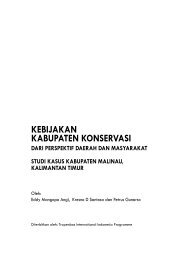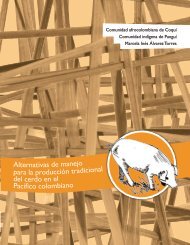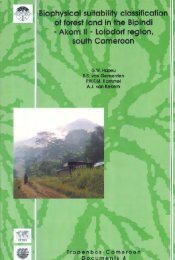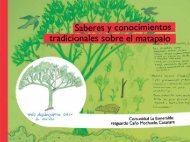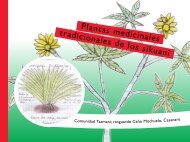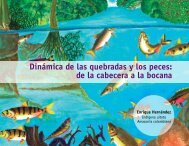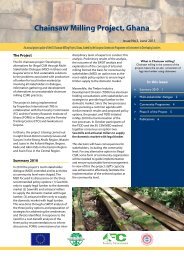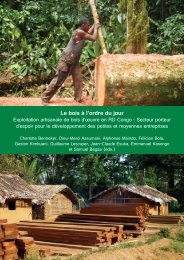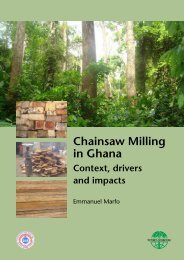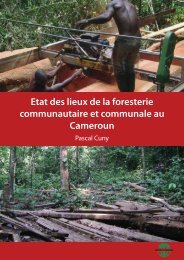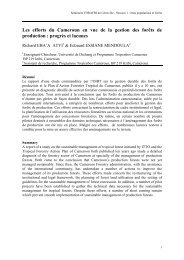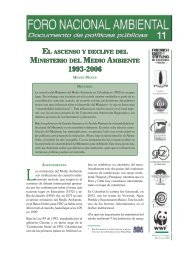Download the publication - Tropenbos International
Download the publication - Tropenbos International
Download the publication - Tropenbos International
Create successful ePaper yourself
Turn your PDF publications into a flip-book with our unique Google optimized e-Paper software.
General conclusions and implications for biodiversity conservation<br />
Table 6.1 Number of species, number of stems/ha, mean basal area/ha and Shannon diversity index (H’)<br />
for all vascular plant species with DBH ≥ 10 cm recorded in some forest areas within <strong>the</strong><br />
Guineo-Congolian region.<br />
No of Stems/ha Mean Shannon Notes Authors<br />
species<br />
basal diversity<br />
Inventory site<br />
Cameroon<br />
area/ha index (H’)<br />
Campo-Ma’an (14.7 ha)* 1116 5312 76.71 5.54 Present study<br />
Campo-Ma’an (14.7 ha) 532 545 72.9 5.26 2297 species of<br />
vascular plants<br />
recorded<br />
including 30<br />
strictly endemic<br />
taxa.<br />
Present study<br />
Dja Wildlife Reserve (26.14 ha) 372 512 32.6 5.46 Sonke (1998)<br />
Korup National Park 410 471 27.8 - Newbery & Gartlan (1996)<br />
Korup National Park (50 ha) 307 492 26.7 1.73 Thomas et al., 2003<br />
Korup National Park (50 ha)* 494 6581 32.2 1.93 1100 species Thomas et al., 2003<br />
Mount Cameroon (7.25 ha) 161 444 33.9 3.99 2433 species Tchouto (1995); Cable &<br />
Gabon<br />
including 49<br />
strictly endemic<br />
taxa.<br />
Cheek (1998)<br />
Doussala (1 ha) 109 425 35.7 - Reitsma (1988)<br />
Lope (12.5 ha) 312 389 34.5 - White (1996)<br />
Minkébé (3 ha) 202 385 - - van Valkenburg et al., 1998<br />
Oveng (1 ha) 131 497 36.4 - Reitsma (1988)<br />
Central African Republic<br />
Ngotto forest (2.5 ha) 147 549 34.4 5.3 Lejoly (1995b)<br />
Congo<br />
Odzala National Park 120 347 21.1 - Lejoly (1995a)<br />
Democratic Republic of Congo<br />
Cuvette Centrale 206 346 32.3 - Wolter (1993)<br />
* for all vascular plant species with DBH ≥ 1 cm<br />
Generally, patterns of species richness and endemism are used for <strong>the</strong> identification<br />
of biodiversity hotspots. During our study, inventory data and taxonomic collections<br />
were used to assess <strong>the</strong> distribution patterns of strict and narrow endemic species.<br />
Conservation indices such as Genetic Heat Index (GHI) and Pioneer Index (PI) were<br />
used to analyse <strong>the</strong> trends in endemic and rare species recorded and geostatistic<br />
techniques helped to evaluate and identify potential areas of high conservation<br />
priority. The results showed that <strong>the</strong> Campo-Ma’an area is characterised by a rich<br />
and diverse flora with more than 2297 species of vascular plants, ferns and fern<br />
allies belonging to 851 genera and 155 families. The area has about 114 endemic<br />
plant species, 29 of that are restricted to <strong>the</strong> area, 29 also occur in south-western<br />
Cameroon and 56 o<strong>the</strong>rs that also occur in o<strong>the</strong>r parts of Cameroon. Fur<strong>the</strong>rmore,<br />
540 species recorded are Lower Guinean endemics, 105 species are Guinean<br />
endemics and 1123 species are Guineo-Congolian endemics. An explanation for this<br />
high incidence of endemism, richness and structured pattern of <strong>the</strong> vegetation might<br />
stem partly from <strong>the</strong> fact that <strong>the</strong> area falls within a series of postulated rain forest<br />
refuges in Central Africa (Hamilton, 1982; White, 1983; Maley, 1987 &1989; Sosef,<br />
1994 & 1996). In such forest refuges, <strong>the</strong> unique combination of climatic and<br />
geological histories, contemporary ecological variables and inherent biological<br />
properties of taxa, may have contributed to speciation (Hawksworth & Kalin-<br />
Arroyo, 1995). The distribution patterns of high conservation priority species<br />
showed a high concentration of <strong>the</strong>se species in <strong>the</strong> National Park between Dipikar<br />
Island and Ebianemeyong-Akom II area, and on Massif des Mamelles and Mont<br />
d”Eléphant. Most of <strong>the</strong> submontane forest and <strong>the</strong> lowland evergreen forest rich in<br />
117



